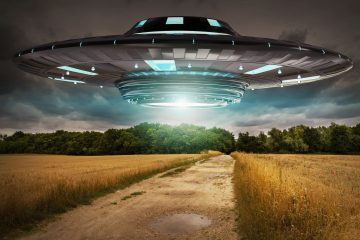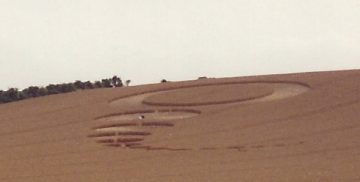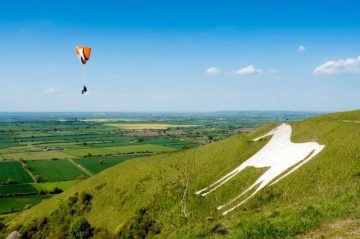by Carol A Westbrook

It’s summer’s end. The fields are golden with ripe grain, bringing thoughts of harvest festivals, hayrides, apple cider… and crop circles. Yes, I can’t drive past a field full of golden grain without keeping my eyes peeled for crop circles.
Scanning for crop circles is a habit I picked up 25 years ago during a trip to Wiltshire County, England. 1994 was the height of the alien frenzy. There were bestseller books, magazines, and TV shows about crop circles, flying saucers and alien abductions. A 1990 Gallup poll found that almost half of all Americans believed we had alien visitors. The highly popular “X-Files” weekly show had a large viewership who tuned in every Sunday evening to watch Special Agents Scully and Mulder investigate paranormal phenomenon, focusing on alien abductions; their slogan was “the truth is out there.” Sensational alien stories swept the nation in these pre-social media days, as people relied on news media and best-seller books for their information. And there were plenty of books and TV specials to stoke your imagination.
A 1994 best-seller, Abduction: Human Encounters With Aliens, by Harvard psychiatrist John Mack, discussed interviews with people who claimed they were abducted by aliens. Oprah and other talk show hosts interviewed abductees. There were books about dead aliens from a flying saucer crash hidden by the government at the top-secret Area 51 in Nevada. The first book about crop circles was published in 1989. The book, Circular Evidence: a Detailed Investigation of the Flattened Swirled Crops Phenomenon was jointly written by Colin Andrews, an electrical engineer from England, and Pat Delgado, a former NASA engineer, concluded that these circles were not a man-made hoax, but remained an unexplained phenomenon. These authors inaugurated the new “science” of crop circles, or cereology. Other self-styled experts from around the world quickly came forward to examine the circles and advance their own theories. More books were written, and organization and institutes devoted to cereology sprang up like, well, crop circles.
 Experts combed these circles, taking soil and plant samples, looking for signs of a space ship’s propulsion, such as radiation or remnants of a plasma vortex. (These studies are still going on today!) The origin of crop circles was hotly debated. It was generally assumed that they couldn’t be man-made because no one could produce works of this magnitude so quickly, in the dark of night, unnoticed, with such perfect symmetry! Instead, they were attributed to ball lightning, plasma vortexes, wind, and animals, but the most favored explanation was they were made by visitors from outer space landing a flying saucer. One expert, Joachim Koch, felt these “cerealoglyphs” were coded messages and actually wrote back to the aliens through a circle that he produced!
Experts combed these circles, taking soil and plant samples, looking for signs of a space ship’s propulsion, such as radiation or remnants of a plasma vortex. (These studies are still going on today!) The origin of crop circles was hotly debated. It was generally assumed that they couldn’t be man-made because no one could produce works of this magnitude so quickly, in the dark of night, unnoticed, with such perfect symmetry! Instead, they were attributed to ball lightning, plasma vortexes, wind, and animals, but the most favored explanation was they were made by visitors from outer space landing a flying saucer. One expert, Joachim Koch, felt these “cerealoglyphs” were coded messages and actually wrote back to the aliens through a circle that he produced!
My husband, Rick, is an electrical engineer with a degree in Space Sciences, and a PhD in plasma physics–better credentials and more experience than most cereologists. He just couldn’t make sense of their speculations, which didn’t seem to obey the laws of physics. Still, he thought there might be something to this phenomenon that could be explained scientifically. Because unlike reports of UFOs and abductions, crop circles were real, physical objects. You could see them, touch them, and feel them. He wanted to see for himself. Me? I thought it was a splendid idea for a vacation.
 In August 1994, we booked our flights and lodging, and headed to England to see for ourselves. Landing at Heathrow, we drove our rental car about 90 miles west, heading toward a B&B in a farmstead in the little town of Devises.
In August 1994, we booked our flights and lodging, and headed to England to see for ourselves. Landing at Heathrow, we drove our rental car about 90 miles west, heading toward a B&B in a farmstead in the little town of Devises.
We were enchanted by Wiltshire. It abounds in mysterious and unexplained landscape phenomena, some of which originate before recorded history. Many of these take the form of circles: there is Stonehenge, and the lesser-known stone circles of Avebury, as well as some circular earthworks attributed to Roman occupation; there are the mysterious circular and oval-shaped earth mounds, the tors, such as Silbury Hill and Kennet Long barrow, which might be prehistoric burial or worship sites. Then there are the white horses, horse-shaped clearings exposing the underlying chalk rock on the hillsides, some of which were created in medieval times. There is the long Ridge Road, built during the Roman occupation, some of which can still be walked today. 
We took our time driving the 90 miles from London, enjoying the Wiltshire countryside. We made the requisite stop at Stonehenge, but were more intrigued by the circle at Avebury, shown at the right, which is not fenced like Stonehenge, so you can touch the stones and walk within the 1/5 mile diameter. We had lunch at the Red Lion pub, which lies at a crossroads in the center of the Avebury circle.
We stopped at the Westbrook Free house (no relation) for a quick pint on the way to our way to our lodgings at Wayside Farm, which was rather difficult to find using paper maps in those pre-GPS days. We settled in for a quiet evening after walking to the nearby pub, and got up to an early and hearty breakfast at the farm table. The farmer was very helpful in directing us to new crop circles; word would get around when one appeared, and he’d give us the road intersections, which gave us our morning quest through the golden countryside. It’s striking to see these beautiful creations, carved into the crops and stretching across the field. Among the five that we found, one was close to the road and easily accessed through the tractor pathways. It is shown in the picture at the top of the article. We began our analysis. 
We were soon joined by a small tour group led by a German self-styled expert. He pointed out to us that the wheat stalks were “bent not broken,” which, he said, clearly indicated an unusual force pushing them down. (I found that if I stomped on the wheat in the field I would get the same result, but what do I know? I wasn’t a cereology expert like he was.) Our colleague was intrigued by Rick’s small portable Geiger counter, but sadly disappointed that it registered no radioactivity greater than background. In fact, there was no evidence of any unusual forces, no sign of burning by hot plasma or rocket fuel, nothing but tramped down wheat circles filled with a number of crop circle enthusiasts. You can see Rick exploring the interior of our crop circle below.
Overall, this was a relaxing visit to a lovely part of the world, but we didn’t make any  remarkable discoveries or find physical evidence of forces that may have created these splendid circles. There was nothing to suggest that they were anything but man-made. I looked at them as artistic expressions, and for some they were an expression of belief in and desire for alien contact, but man-made nonetheless.
remarkable discoveries or find physical evidence of forces that may have created these splendid circles. There was nothing to suggest that they were anything but man-made. I looked at them as artistic expressions, and for some they were an expression of belief in and desire for alien contact, but man-made nonetheless.
What we didn’t learn until we returned to the US, was that crop circles had already been exposed as being man made: On Sept 11, 1991, two pint-loving English watercolor artists, Doug Bower and David Chorley, revealed to the British press that they created these circles, making their first one in 1978. Apparently, after a few drinks in a pub, they were inspired to create a “flying saucer nest,” which they did in the dead of night by walking in a field and using simple planks and ropes. As the press got interested, many more followed. You can see Doug and Dave in action in this video from their TV broadcast; click this link.
What was remarkable to us is that this news never made a big splash in the US! Mysterious crop circles were news; exposing them as a hoax was not. Truly, no one wanted to hear that crop circles were man-made!
The expert cereologists also refused to believe that the circles were all man-made. Dave and Doug’s were “fake” circles, because “real” crop circles had otherworldly origins. So many people believed these experts that they were not about to change their beliefs. Many of the crop circle experts have since back-pedaled and accept human creation for most–but not ALL–crop circles. The Journal of Cereology is still being published, and crop circles are still appearing in many sites around the world, many of which are admittedly man-made. Croppies continue to insist on their alien origin.
 To me, the most interesting question about crop circles is why belief in their alien origin persists, in spite of all the evidence to the contrary. The answer, I feel, is that these beliefs reveal a desire to believe in a higher power that transcends humanity. In these days of declining acceptance of organized religion, believing in superhuman aliens fills this need for many people. To them, connecting these mysterious apparitions to other presumed alien interventions gives substance to their beliefs. I am reminded of the poster displayed above Agent Mulder’s desk on the TV series “X-files.” It depicted a flying saucer, with the caption, “I want to believe.”
To me, the most interesting question about crop circles is why belief in their alien origin persists, in spite of all the evidence to the contrary. The answer, I feel, is that these beliefs reveal a desire to believe in a higher power that transcends humanity. In these days of declining acceptance of organized religion, believing in superhuman aliens fills this need for many people. To them, connecting these mysterious apparitions to other presumed alien interventions gives substance to their beliefs. I am reminded of the poster displayed above Agent Mulder’s desk on the TV series “X-files.” It depicted a flying saucer, with the caption, “I want to believe.”
Do you believe?
